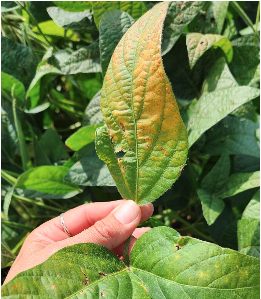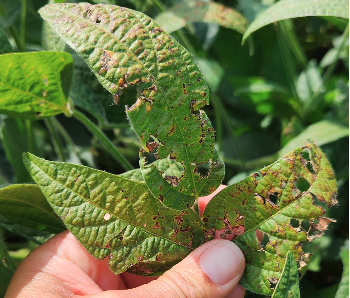Each year, we never know what we are going to see or find when it comes to diseases in our soybean fields. Every year has a different environment, weather phenomena, and planting conditions. This year is no different. We’ve had many challenges thrown at this crop starting with difficult planting conditions, followed by extreme hot and dry conditions, and even wet conditions throughout the season. Many diseases can infect corn and soybeans early in the season, but symptoms do not appear in the crop until the grain fill period.
One of the diseases affecting soybeans, though not frequently discussed, is cercospora leaf blight. We started observing different leaf coloration in some of the soybean varieties in our soybean plot in early September. This disease first appeared in our plot, making it easy to spot the differences between soybean varieties side by side, with some being affected and others not. A few days later, cercospora leaf blight started appearing in grower’s fields.
Cercospora leaf blight (CLB) is caused by a fungus, Cercospora kikuchii, and becomes active in the spring during hot and humid weather. This fungus can be present in fields within soybean debris and some weed species or unclean seed that was planted. Wind and water disperse spores from crop debris onto small soybean plants¹. Lesions can be small and go unnoticed on the lower canopy. During pod fill, under warm, humid conditions and sun exposure, the upper canopy leaves turn a dark green, bronze/purple color and become leathery. Leaves will eventually become necrotic and drop off, mimicking early maturity².
If you have a field infected with CLB, there are a few integrated pest management options for control. If this disease goes untreated, yield effects of up to 30 percent have been reported with high pressure³. The best option is genetic control; plant soybean seeds free of infection and varieties that are resistant to CLB³. If you have CLB in your fields this year, you can take cultural steps to help avoid carryover for your next soybean crop. Crop rotation can help break up the disease cycle or the inoculum in the field. Tillage can help reduce the survival of the fungus by burying debris that is infected. In severe cases, complete removal of all crop debris may be necessary to prevent disease spread³. Fungicides can also be an effective tool if applied at the correct timing. Typically, this is prior to infection, and an R3/R4 fungicide application should help prevent the disease if the fungicide used is labeled for CLB⁴.
Harvest difficulties may also come about with CLB. As mentioned before, CLB can mimic early maturity, and the leaves will often fall off prior to full maturity of the plant. When a soybean plant matures naturally the leaves and petioles fall off. When a plant is infected by CLB, the leaves will prematurely fall off, leaving behind the petioles. Also, the lower leaves remain attached⁵. This can make harvest difficult for some, as plants can be difficult to harvest.
Additionally, this disease has the potential to lead to seed quality issues during harvest. Cercospora kikuchii is also the fungi that can cause purple seed stain in soybean. Although purple seed stain does not directly affect yield, it could be a quality issue in samples at the elevator. At high levels of discoloration, loads can be docked or rejected.⁵
If you detect cercospora leaf blight in your field, take the time to scout and talk to a trusted agronomist. Work with them to determine the causes and severity of the disease and determine if this disease is caused by infected seed or an environmental cause. This will help you make decisions moving forward and determine what integrated pest management decision would be best in your operation.
Sources:
- University of Missouri Integrated Pest Management. “Cercospora Leaf Blight of Soybean.” https://ipm.missouri.edu/croppest/2021/11/cercosporaLeafBlightSoybean-PT/.
- Crop Protection Network. “Cercospora Leaf Blight of Soybean.” https://cropprotectionnetwork.org/encyclopedia/cercospora-leaf-blight-of-soybean.
- Bayer Crop Science. “Cercospora Leaf Blight.” https://www.cropscience.bayer.us/articles/channel/cercospora-leaf-blight.
- Oklahoma State University Extension. “Foliar Diseases of Soybeans.” https://extension.okstate.edu/fact-sheets/print-publications/epp-entomology-and-plant-pathologhy/foliar-diseases-of-soybeans-epp-7672.pdf.
- University of Nebraska–Lincoln. “Purple Seed Stain of Soybean.” CropWatch, https://cropwatch.unl.edu/plantdisease/soybean/purple-seed-stain.





 and then
and then